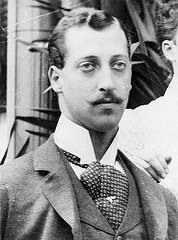
Prince Albert Victor Christian Edward was the duke of Clarence and Avondale. He was born on the 8th January 1864 and died on the 14th of January 1892 from influenza. Albert Victor was born two months premature. He was christened in the private chapel of Buckingham palace. He was the son of Albert Edward, Prince of Wales and Alexandra, Princess of Wales (later to be King Edward VII and Queen Alexandra) . He was the grandson of the reigning monarch Queen Victoria. His brother was born when he was only 17 months old and because of the closeness in age they were educated together. They were assigned a tutor by Queen Victoria and were given a strict program of strict study, which contained games and military drills as well as academic subjects. When he was young he travelled the world as a navel cadet and as an adult he joined the army but didn't undertake any military duties. He was engaged to marry Mary of Teck in late 1891 and then a few weeks later he died. Mary later married his younger brother George, who later became King George V in 1910.
Prince Albert Victor’s intellect, sexuality and sanity have linked him to being Jack the Ripper. He was apparently a 'slow' child and grew up to be a rather dull adult. He was a dear, good, kind and considerate man. He was also self-indulgent, not punctual and had no proper education. There were rumors that he was also mildly retarded. His intelligence was lower than expected for a future monarch with limited mental ability. He was partially deaf as he had inherited hearing problems.
RELATIONSHIP TO MURDERS
One thought to his relationship with the murders hadn't appeared until 1970 when Dr Thomas Stowell wrote an article about Jack the Ripper who he named as being Prince Albert Victor. He said that he had based his theory on private papers of Sir William Gull. In theory the syphilis drove him insane which compelled him to commit the murders and his family knew that he was Jack the Ripper after the second murder. Gull was Eddy's doctor who had informed his father that his son was dying of a syphilitic infection. Apparently no attempt was made to restrain until the double event when he was taken away in restraints to a private hospital. He then escaped to commit the final murder. He was then put in hospital again and died of "softening of the brain". Dr Thomas Stowell was said to have burnt the papers and then died later before it could be proven that the papers even existed.
According to Royal records Eddy had an alibi for each of the murders but if Stowell's theory is correct then it could have all been a cover up as it was said that the family knew Eddy was Jack the Ripper. On the 29th of August until the 7th of September he was in Yorkshire during the Nicholls death. On the 7th of September until the 10th of September he was in York during Chapman murder. On 27th of September until 30th of September he was in Scotland during Stride and Eddowes murder. On the 2nd of November until the 12th of November he was at Sandringham.
EVIDENCE
Prince Albert apparently had no medical knowledge but was very experienced in 'dressing dear'. He had syphilis of the brain which drives you insane which Jack the Ripper clearly was. It was also said that a royal carriage was used for the murders. Prince Albert was revealed by pimps that he was one of their clients in a male brothel in London. This was then covered up by the royal family. If this was covered up they could have covered up him being Jack the Ripper. It was also said that he had a child with a woman from whitechapel and could have been the killer to protect his reputation as a respected member of the royal family.
MOTIVE
One of Prince Albert’s motives was that he wanted revenge on prostitutes because one had given him syphilis of the brain. Another possible motive is that he was to married a prostitute, which was not a good image for the royal family so he had to kill her and her friends that knew of the marriage. Another is that he just went insane because of the syphilitic infection and the pain it was causing him.
Throughout Albert's life he was treated with nothing but respect and was known as a good, honest man.
REFERENCES

